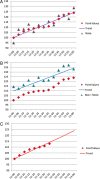Continuous glucose control in the ICU: report of a 2013 round table meeting
- PMID: 25041718
- PMCID: PMC4078395
- DOI: 10.1186/cc13921
Continuous glucose control in the ICU: report of a 2013 round table meeting
Abstract
Achieving adequate glucose control in critically ill patients is a complex but important part of optimal patient management. Until relatively recently, intermittent measurements of blood glucose have been the only means of monitoring blood glucose levels. With growing interest in the possible beneficial effects of continuous over intermittent monitoring and the development of several continuous glucose monitoring (CGM) systems, a round table conference was convened to discuss and, where possible, reach consensus on the various aspects related to glucose monitoring and management using these systems. In this report, we discuss the advantages and limitations of the different types of devices available, the potential advantages of continuous over intermittent testing, the relative importance of trend and point accuracy, the standards necessary for reporting results in clinical trials and for recognition by official bodies, and the changes that may be needed in current glucose management protocols as a result of a move towards increased use of CGM. We close with a list of the research priorities in this field, which will be necessary if CGM is to become a routine part of daily practice in the management of critically ill patients.
Figures


Comment in
-
Tight glycemic control in the ICU - is the earth flat?Crit Care. 2014 Jun 27;18(3):159. doi: 10.1186/cc13950. Crit Care. 2014. PMID: 25041720 Free PMC article.
References
-
- Finfer S, Wernerman J, Preiser JC, Cass T, Desaive T, Hovorka R, Joseph JI, Kosiborod M, Krinsley JS, MacKenzie I, Mesotten D, Schulz M, Scott MG, Slingerland R, van den Berghe G, Van Herpe T. Consensus recommendations on measurement of blood glucose and reporting glycemic control in critically ill adults. Crit Care. 2013;17:229. doi: 10.1186/cc12537. - DOI - PMC - PubMed
-
- Gough DA, Kreutz-Delgado K, Bremer TM. Frequency characterization of blood glucose dynamics. Ann Biomed Eng. 2003;31:91–97. - PubMed
-
- Klonoff DC, Bernhardt P, Ginsberg BH, Josepg J, Mastrototaro J, Parker D, Vesper H, Vigersky R. POCT05-A: Performance Metrics for Continuous Interstitial Glucose Monitoring; Approved Guideline. Wayne, PA: Clinical and Laboratory Standards Institute; 2008.
-
- Aragon D. Evaluation of nursing work effort and perceptions about blood glucose testing in tight glycemic control. Am J Crit Care. 2006;15:370–377. - PubMed
Publication types
MeSH terms
Substances
LinkOut - more resources
Full Text Sources
Other Literature Sources
Medical

